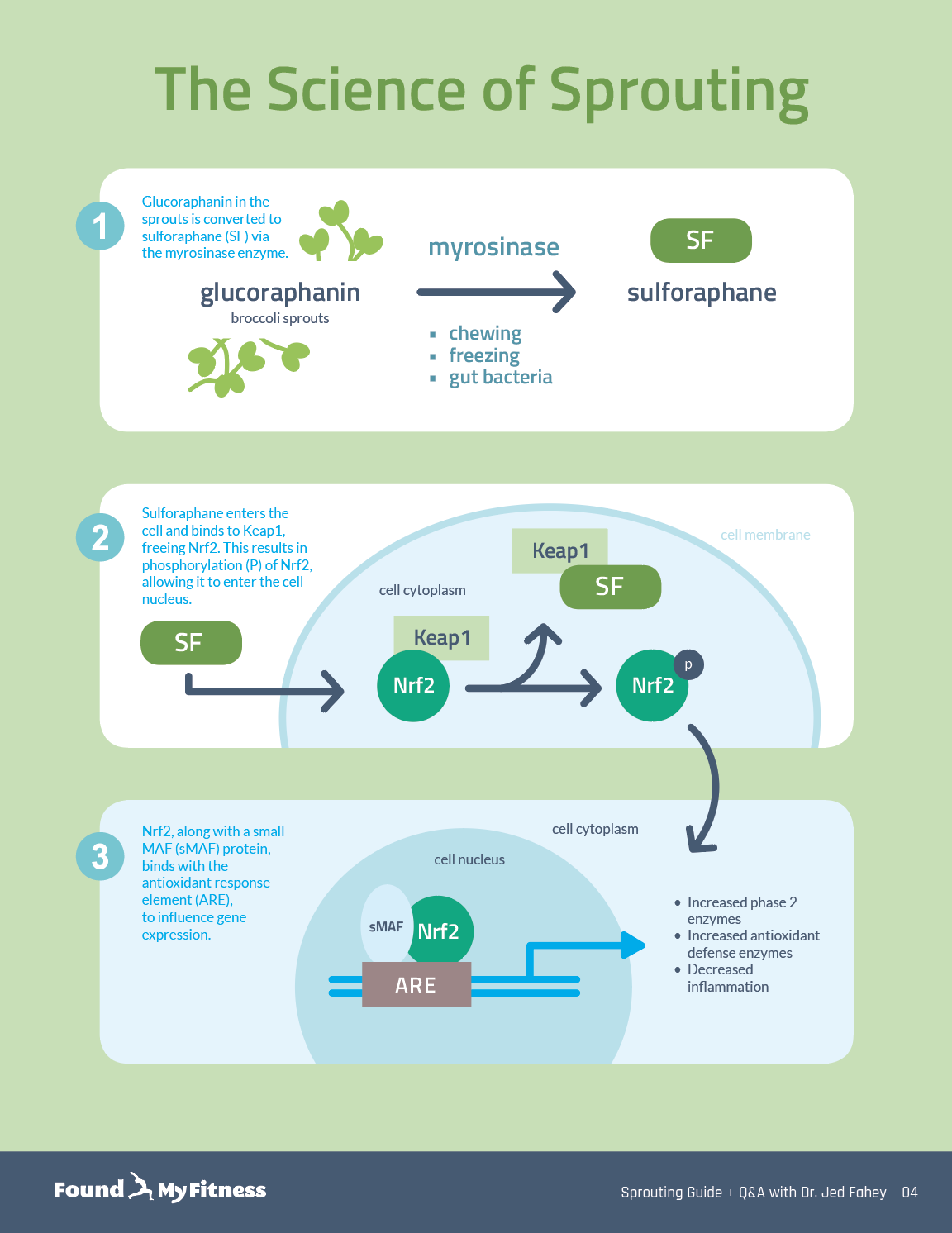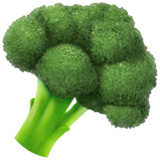Sulforaphane’s effect on urinary health | Jed Fahey
Enter your email to get our 15-page guide to sprouting broccoli and learn about the science of chemoprotective compount sulforaphane.
Broccoli sprouts are concentrated sources of sulforaphane, a type of isothiocyanate. Damaging broccoli sprouts – when chewing, chopping, or freezing – triggers an enzymatic reaction in the tiny plants that produces sulforaphane.

Get the full length version of this episode as a podcast.
This episode will make a great companion for a long drive.
The byproducts of sulforaphane metabolism include a variety of glutathione-derived conjugates. These antioxidant compounds eventually end up in the urine, which is temporarily stored in the bladder prior to elimination, providing a unique environment in which to study the effects of sulforaphane and its metabolic byproducts on bladder tissue. Although human trials are lacking, some animal research suggests that sulforaphane and its byproducts protect against bladder cancer. In this clip, Dr. Fahey describes the metabolic fate of sulforaphane and the current state of research on its effects against bladder cancer.
Jed: But one of the trials that you won't see a publication on, that I'm very sad did not get to completion and did not really accrue enough patients and I hope we can find collaborators to do a trial on this, is bladder cancer prevention. And, again, I go back to my old friend Yuesheng Zhang at Roswell Park Cancer Institute in Buffalo. He made the observation many, many years ago that, gee, when you think about how sulforaphane courses through the body, it winds up being excreted in the urine as either sulforaphane free and clear, or the majority of it comes out as its conjugates with glutathione, one of the main antioxidant peptides in the body. Glutathione or acetylcysteine sulforaphane, a variety of sort of antioxidant, glutathione-derived conjugates. And all of them have some activity in up-regulating Nrf2, also. So what happens? Go in here, you eat sulforaphane or you ingest it or you can even put it on your skin. We've done a number trials showing protection against ultraviolet radiation. It gets metabolized, it gets excreted. How does it get excreted? In the urine. What happens to urine? It hangs around in the bladder. So what you wind up having is a high concentration, relatively high concentration of both sulforaphane and its active metabolites in the bladder bathing that bladder epithelium and it's only, obviously, periodically released.
We think it would be the perfect place to demonstrate protection against cancer or cancer prevention. And so we actually had permission for and started and only accrued, I think, only enrolled, I think, one or two subjects a trial in which we were to look at just that. And these were people, where we were looking at secondary reappearance of bladder cancer. So they had had a tumor removed that had cystectomy and we were looking at the health of the bladder and levels of Nrf2 in bladder tissue that was acquired by biopsy.
So that was the design of this study. As I say, it didn't happen. We're actually trying to get one off the ground with dogs now. Dogs are a little different because they sort of pee when they want to. So there's probably not the same constant reservoir of sulforaphane and its metabolites in the bladder, but certainly to a degree, there will be. It's also harder to collect the 24-hour urine on a dog and to do some of the interventions. But so we are trying to get a canine bladder cancer prevention trial off the ground. And as I say, we'd love to see it done in humans because it's...if there was a gimmie, that's a gimmie. I mean, it's got to work there if it's going to work anywhere.
Rhonda: The epidemiology is so strong showing, I mean, I can just, study after study after study showing cruciferous intake raw broccoli it's showing...and preventing bladder recurrence, as well. People that are eating these foods, it's not a clinical trial, but it's just associative data. And there's been animal studies with bladder cancer where they give them some carcinogen and sulforaphane in it. So I agree with you. I mean, it would be really nice to see an actual clinical trial done in humans and it does make perfect sense. Prostate cancer is another one that seems to also sort of go hand in hand. I mean, the prostate and prostate inflammation seems to be lowered and one study is showing that men with prostate cancer that were given pretty relatively high doses of sulforaphane, it slowed their doubling rate of the PSA by 86%. So, I mean, that's pretty significant.
Jed: Yeah, yeah. So there are two prostate cancer studies...well, there are probably more. But Joshi Alumkal at OHSU did one and Bernard Cippola in France using, actually, the supplement. So Cippola's study used, where he showed a dramatic reduction in the trajectory of PSA numbers was in, used... What's it called?
Rhonda: Prostaphane?
Jed: Prostaphane, thank you. Yeah, the French supplement. And Alumkal's study used our homemade broccoli sprout extract. You mentioned the animal studies. We actually were partnered on three or four animal studies with Yuesheng Zhang and Rex Munday in New Zealand. And it was extremely impressive to see the difference in bladder cancer.
Rhonda: Right, tumor size.
Jed: Tumor number, tumor size and number.
Rhonda: I mean, it was. I saw the publication, extremely robust.
Jed: Yeah. Nice, gross color pictures, too.
Rhonda: Yeah, I'm convinced, yeah. You know, and the other thing is smokers. Smokers get bladder cancer and that, you know...I think, first of all, people that smoke should quit smoking first and foremost, but if they don't quit smoking, I mean, I think they should be consuming broccoli sprouts like nobody's business because they're accumulating so much benzene and all sorts of carcinogens.
A molecule that inhibits oxidative damage to DNA, proteins, and lipids in cells. Oxidative damage plays a role in the aging process, cancer, and neurodegeneration. Many vitamins and plant-based compounds are antioxidants.
An aromatic hydrocarbon compound produced during the distillation and burning of fossil fuels, such as gasoline. It is also present in the smoke from forest fires, volcanoes, and cigarettes. Benzene is a carcinogen that targets the liver, kidney, lung, heart, and brain and can cause DNA strand breaks, chromosomal damage, and genetic instability.
An antioxidant compound produced by the body’s cells. Glutathione helps prevent damage from oxidative stress caused by the production of reactive oxygen species.
A critical element of the body’s immune response. Inflammation occurs when the body is exposed to harmful stimuli, such as pathogens, damaged cells, or irritants. It is a protective response that involves immune cells, cell-signaling proteins, and pro-inflammatory factors. Acute inflammation occurs after minor injuries or infections and is characterized by local redness, swelling, or fever. Chronic inflammation occurs on the cellular level in response to toxins or other stressors and is often “invisible.” It plays a key role in the development of many chronic diseases, including cancer, cardiovascular disease, and diabetes.
A protein typically present in the cytoplasm of mammalian cells. Nrf2 can relocate to the nucleus where it regulates the expression of hundreds of antioxidant and stress response proteins that protect against oxidative damage triggered by injury and inflammation. One of the most well-known naturally-occurring inducers of Nrf2 is sulforaphane, a compound derived from cruciferous vegetables such as broccoli.
An isothiocyanate compound derived from cruciferous vegetables such as broccoli, cauliflower, and mustard. Sulforaphane is produced when the plant is damaged when attacked by insects or eaten by humans. It activates cytoprotective mechanisms within cells in a hormetic-type response. Sulforaphane has demonstrated beneficial effects against several chronic health conditions, including autism, cancer, cardiovascular disease, diabetes, and others.
Hear new content from Rhonda on The Aliquot, our member's only podcast

Listen in on our regularly curated interview segments called "Aliquots" released every week on our premium podcast The Aliquot. Aliquots come in two flavors: features and mashups.
- Hours of deep dive on topics like fasting, sauna, child development surfaced from our enormous collection of members-only Q&A episodes.
- Important conversational highlights from our interviews with extra commentary and value. Short but salient.
Sulforaphane News
- Sulforaphane extends lifespan and healthspan in worms via insulin and insulin-like growth factor-1 signaling.
- Paul Saladino, MD explains how we may have overstated the health benefits of plants and especially sulforaphane
- NRF2 much of a good thing (December 2017)
- A pilot trial finds sulforaphane treatment increased glutathione levels in the blood & hippocampus region of the brain in healthy people.
- A new study found sulforaphane (found in broccoli sprouts) improved behavior & social responsiveness in children with autism.





































































